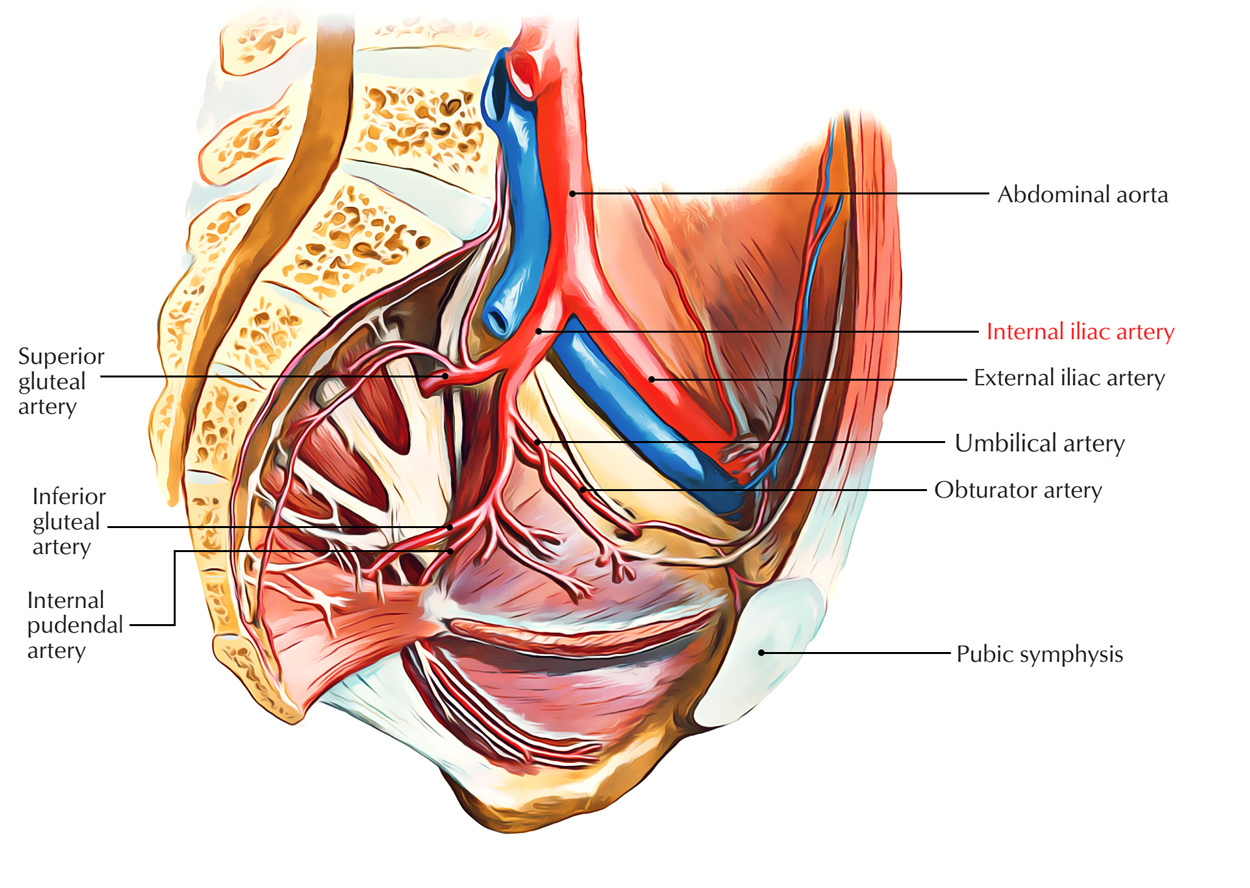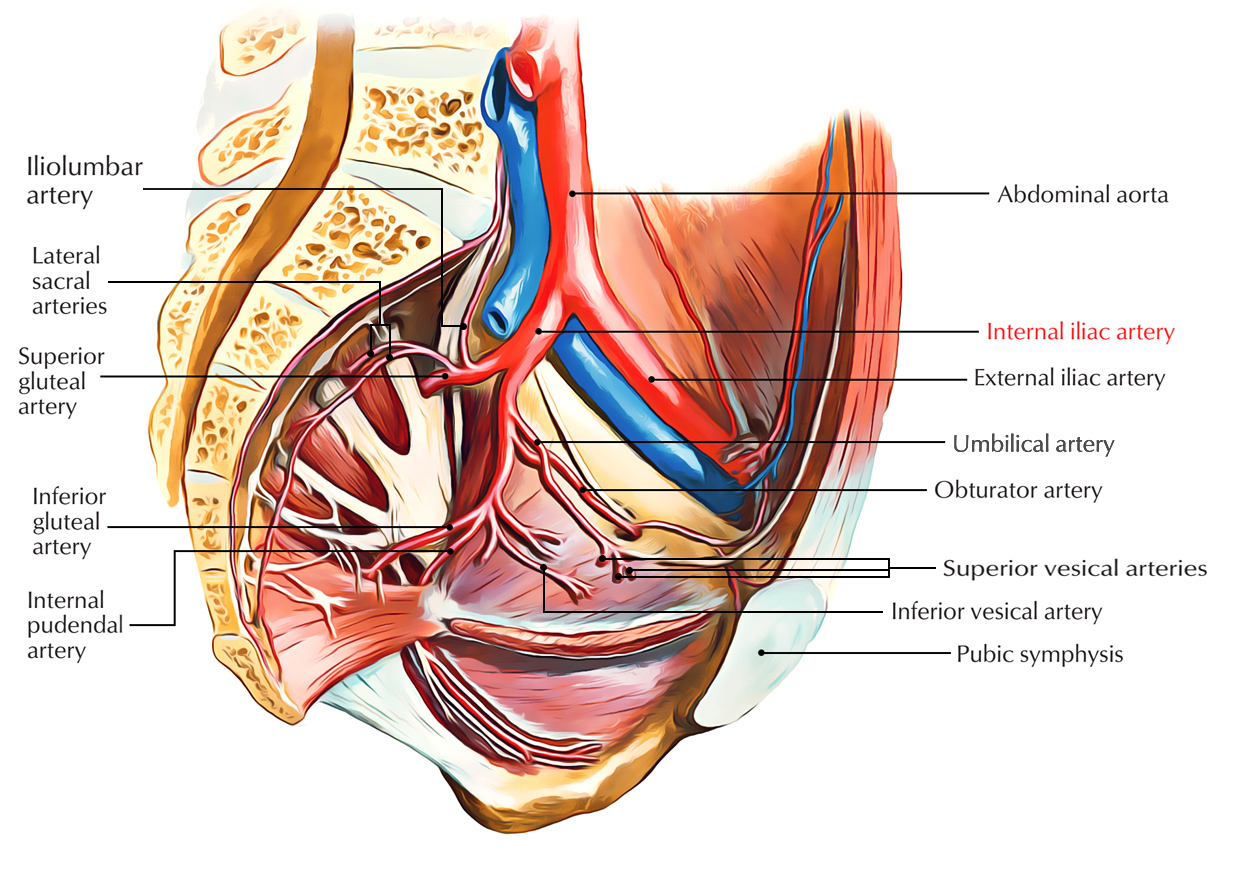The internal iliac artery is the primary artery of the pelvis. It supplies the pelvic wall, pelvic viscera, perineum, reprodductive organs, medial portion of thigh and buttocks.

Internal Iliac Artery
Origin
The internal iliac artery emerges anterior to the sacroiliac joint via the common iliac artery. It is slimmer compared to the external iliac artery, the course of which it trails towards the border among the greater as well as lesser pelvis where it reaches the lacuna vasorum under the inguinal ligament, which is the primary extension of the common iliac artery.
Insertion
The internal iliac artery goes lateral towards the internal iliac vein descends within the lesser pelvis. The internal iliac artery exits the common iliac artery where the ureter moves in the pelvirectal fascia anterior to. The internal iliac artery goes at the parietal pelvic fascia to the superior margin of the piriformis muscle and medial towards the obturator nerve. It splits in visceral as well as parietal sections at this point.
Variations
There are two trunks present, anterior and posterior in 50% of instances, which shows the division of the internal iliac artery is highly diverse. The lateral sacral artery arises from the posterior trunk or the superior gluteal artery. The posterior trunk produces the superior gluteal artery has superficial, deep as well as superior sections, the inferior gluteal artery circulates the artery towards the sciatic nerve, the iliolumbar artery has lumbar, spinal as well as iliac sections, and the lateral sacral artery has a spinal section.
Position
The artery is located at the back of the ureter, the tube that brings urine from the kidney to the urinary bladder and anterior to the internal iliac vein. The obturator nerve is placed under it, while the external iliac vein is medial to it, nearer compared to the internal branch to the midline of the body. From one person to another the precise organization of the branches of this artery differs. In women, the artery that circulates blood to the uterus is typically a branch of the internal iliac. In fetuses, an extension of the internal iliac, referred to as the umbilical artery, belongs to the umbilical cord.
Branches
Posterior Trunk
The iliolumbar artery, the lateral sacral artery, and the superior gluteal artery are the branches of the posterior trunk of the internal iliac artery

Internal Iliac Artery: Branches
Iliolumbar Artery
- Origin: Posterior trunk of internal iliac artery.
- Pathway: rises laterally, departs from the pelvic inlet and splits into a lumbar branch and an iliac branch.
- Branches: Lumbar and Iliac.
- Supply: The lumbar branch adds to the supply of the posterior abdominal wall, psoas and quadratus lumborum muscles, and cauda equina, by means of a small spinal branch iliac travels through the intervertebral foramen in between LV and SI. The iliac branch moves laterally into the iliac fossa to supply muscle and bone.
Lateral Sacral Arteries
- Origin: Posterior trunk of internal iliac artery.
- Attachments: Travels medially and inferiorly along with the posterior pelvic wall.
- Branches: Superior and inferior sacral branches.
- Supply: Sacral meninges, Piriformis muscle, Erector spinae muscles, cutaneous area over sacrum.
Superior Gluteal Artery
- Origin: The posterior division of the internal iliac artery.
- Supply: Cutaneous and muscular to gluteal region, contributes to anastomoses around the hip and anterior superior iliac spine.
- Main branches: Superficial and deep branches, the deep branch has upper and lower divisions.
- Insertion: Generally passing in between the lumbosacral trunk and anterior ramus of S1, it passes posteriorly to exit the pelvic cavity via the greater sciatic foramen above the piriformis muscle and get in the gluteal zone of the lower limb.
Anterior Trunk
Branches of the anterior trunk of the internal iliac artery consist of the umbilical artery, the superior vesical artery, the inferior vesical artery, the middle rectal artery, the obturator artery, the internal pudendal artery, the uterine artery, the vaginal artery, and the inferior gluteal artery.

Internal Iliac Artery: Anterior Trunk
Umbilical Artery
- Origin: anterior division of the internal iliac artery.
- Attachments: Joins Placenta in mother and abdomen in fetus.
- Location: abdominal wall and pelvis.
- Supply: placenta in the fetus, superior bladder, ureter, ductus deferens.
- Main branches: umbilical artery (eliminated), superior vesical artery.
Superior Vesical Artery
- Origin: anterior trunk of internal iliac artery.
- Insertion: It travels along the pelvic sidewall then courses medially toward the upper portion of the bladder within a fold of peritoneum.
- Supply: It supplies ductus deferens, superior bladder, and ureter.
- Branches: middle vesical, artery to the ductus deferens.
Inferior Vesical Artery
(Appears in men)
- Origin: Anterior trunk of internal iliac artery.
- Supply: Urinary bladder, Ureter, Seminal vesicle, and Prostate gland.
- Insertion: It passes medially along the pelvic floor towards the fundus of the bladder.
- Branches: Prostatic artery, artery towards the ductus defrenes.
Vaginal Artery
(Women)
- Origin: Anterior trunk of the internal iliac artery.
- Insertion: It descends to the vagina, supplying its mucous membrane. It can send branches to the bulb of the vestibule, the fundus of the bladder, and the contiguous part of the rectum.
- Supply: Mucous membrane of vagina, vestibular bulb, rectum, fundus of urinary bladder.
- Branches: Vaginal branch and Inferior vesical branch.
Middle Rectal Artery
- Origin: Anterior trunk of the internal iliac artery.
- Insertion: It is distributed to the rectum, anastomosing with the inferior vesical artery, superior rectal artery, and inferior rectal artery.
- Supply: In males, Inferior rectum, seminal vesicles, and prostate. In females, it can be replaced by the uterine artery
- Branches: Branches towards rectum, seminal vesicle and prostate.
Obturator Artery
- Origin: Anterior trunk of internal iliac artery.
- Insertion: Goes anteriorly along the pelvic wall and leaves the pelvic cavity by means of the obturator canal. Along with the obturator nerve, above, and obturator vein, listed below, it goes into the adductor region of the thigh.
- Branches: Anterior and posterior branches, Artery within the ligament of the femur, Iliac branch, Pubic branch, and Branch to the knee capsule.
- Supply: pelvic muscles, ilium, head of femur, muscles of medial thigh and skin.
Internal Pudendal Artery
- Origin: Anterior trunk of internal artery.
- Insertion: Gets out of the pelvic cavity via the greater sciatic foramen inferior towards the piriformis muscle and goes inferiorly via its origin in the anterior trunk. In combination with the pudendal nerve on its medial side, the vessel travels laterally towards the ischial spine then via the lesser sciatic foramen to get in the perineum. The primary artery of the perineum is the internal pudendal artery.
- Supply: It supplies the erectile tissues of the clitoris along with the penis are amongst the structures.
- Branches: Inferior rectal artery, Deep artery of the penis/clitoris, Dorsal artery of the penis/clitoris, Perineal artery, Posterior scrotal artery, Transverse perineal artery and Artery to the bulb.
Inferior Gluteal Artery
- Origin: Anterior trunk of internal iliac artery
- Insertion: It passes in between the anterior rami SI and S2 or S2 and S3 of the sacral plexus and leaves the pelvic cavity through the greater sciatic foramen inferior towards the piriformis muscle.
- Supply: Gives to the blood supply of the gluteal region and anastomoses with a network of vessels around the hip joint.
- Branches: Muscular branches towards piriformis, obturator internus, and gluteus maximus. The companion artery to the sciatic nerve and support to trochanteric and cruciate anastomoses.
Uterine Artery
- Origin: Via anterior trunk of internal iliac artery, it rises along the lateral margin of the uterus to reach the uterine tube as soon as the vessel enters the cervix, where it arcs laterally and anastomoses with the ovarian artery.
- Insertion: in women courses medially as well as anteriorly in the base of the broad ligament to reach the cervix. Towards the lateral vaginal fornix along its course the vessel goes across the ureter and passes superiorly.
- Supplly: The uterine artery is the major blood supply to the uterus and expands considerably during pregnancy. Via anastomoses along with other arteries, the vessel adds to the blood supply of the ovary as well as vagina too.

 (53 votes, average: 4.83 out of 5)
(53 votes, average: 4.83 out of 5)